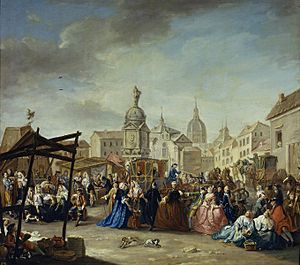Fountain de la Abundancia facts for kids
The Fountain of la Abundancia, also known as Fuente de la Abundancia, was a famous fountain in Madrid, Spain. It stood in the Plaza de la Cebada, which was sometimes called by the fountain's name. This beautiful fountain was taken down in the 1800s. Luckily, some parts, like its decorations and coats of arms, were saved. These pieces were later used in a new structure.
Today, you can find some parts of the original fountain in another large fountain called La Fuentecilla. This fountain is on Calle de Toledo. It was built in 1815 to honor King Ferdinand VII. There is also a sculpture of a woman with a child. Some people think this is the "Abundance" figure that gave the original fountain its name.
Contents
History and Design of the Fountain

The Fountain of la Abundancia was designed in 1617. A Madrid architect named Juan Gómez de Mora created its plans. He also designed another fountain around the same time. The building of the fountain was handled by master builder Pedro Pedrosa and stonemason Martín de Gortayri.
Gómez de Mora wanted the fountain to look more like a sculpture than a building. It showed influences from the Herrerian style. However, it also had touches of the newer Baroque style that was becoming popular.
What the Fountain Looked Like
The fountain was shaped like a square temple. It had a classic look, similar to ancient Roman or Greek buildings. Each of its four sides had a triangular top, called a pediment. On top of the fountain was a dome. Resting on the dome was a sculpture of "Abundance."
The front of the fountain was decorated with coats of arms. These symbols represented the City of Madrid and the Spanish Crown. One of the most interesting parts was an open space in the middle. Inside this space were four bears that spouted water. Bears are a famous symbol of Madrid.
Changes to the Original Plan
The fountain that was actually built had some changes from the first design. The original plan was for a taller, thinner structure. The top part was supposed to rest on a stronger base. This base was meant to have carved masks instead of coats of arms.
For the very top, Gómez de Mora first thought about adding a small obelisk. But in the end, a statue of Abundance was placed there. The city council of Madrid bought this statue from an Italian merchant in 1617. It showed a woman standing with a child on her right side.
No one knows for sure what happened to this sculpture after the fountain was destroyed in 1840. Some experts believe that an alabaster statue in the Museo de Historia de Madrid is the original Abundance figure.
Today, a modern iron fountain stands near where the old Fountain of la Abundancia once was. It has a round basin and a central pole with eight water spouts. This fountain was opened in 1999. It is part of the newer area where Calle de Toledo meets Plaza de la Cebada. This modern fountain is very different from the original design by Gómez de Mora. It shows the style of iron architecture that became popular later in the 1800s and early 1900s.
La Fuentecilla: A New Use for Old Parts
The La Fuentecilla fountain was built using materials from different old buildings. Its main body, made of granite, came almost entirely from the Fountain of la Abundancia.
La Fuentecilla also used the triangular pediments and some of the city's coats of arms from the Fountain of la Abundancia.
On top of La Fuentecilla, a sculpture of a lion with two globes was placed. The globes represented Spain's lands overseas. This lion statue was saved from the Convent of the Premonstratensians. That convent was destroyed during the Napoleonic invasion.
Even though La Fuentecilla works as a public fountain, its main purpose was to celebrate. It was built to honor the return of King Ferdinand VII after the War of Independence ended.
See also
 In Spanish: Fuente de la Abundancia para niños
In Spanish: Fuente de la Abundancia para niños


